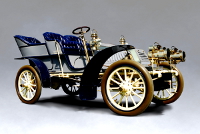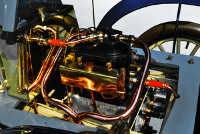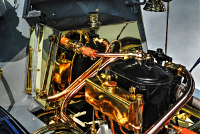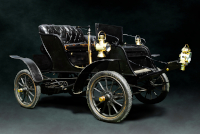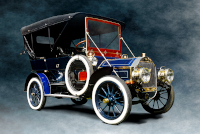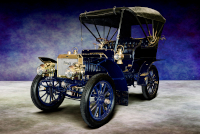Location:
Radnor Hunt Concours d'Elegance, 2007
Owner: John H. Hovey | Wyckoff, New Jersey
Prologue:
Special thanks to Mr. John Hovey, who dearly answered questions and showed us around the car. Mr. Hovey completed much of the restoration himself, and was particularly proud of the brass work he fashioned for the bonnet.
Radnor Hunt 2007 excited me, as I grew up with a fondness toward Pierce-Arrow owing to a childhood encounter at a Boston garage where a dear family friend, Mr. John J. Paino, worked on local antiques. On one visit, he toured my father and me through a Pierce-Arrow opera coupe. The Pierce-Arrow name stuck from that point, altogether a class and flash evocation, (nothing so old and crusty as Hupmobile). Moving forward a few decades, the chance to see a show featuring Pierce-Arrow seemed well and truly perfect. In many ways, that show gave me the idea to start a portfolio dedicated to the marque, something along the lines of an online concours d'elegance blended with the discipline of Automobile Quarterly.
New to the concours d'elegance world, I spent some while browsing photographs from other shows, and spotted this two-tone colonial blue Pierce from the 2005 edition of Pebble Beach. Finding the same car at Radnor Hunt became a personal highlight. All the better to chat with the owner and enjoy how the natural radiance of a warm summer day brightened the paint and tinted the brass. Of course, it has taken me well over a decade to gain proper momentum on this 12cylinders process. But as this Pierce-Arrow portfolio gears up, I remain thrilled to bits with this first find, what will always be one of my favorite brass era motorcars.
- - - - - - - - - -
► Image Source: Nikon D200 (10.2 MP)
References:
- Ralston, Marc. "Pierce-Arrow" A.S. Barnes & Co., Inc., San Diego, CA. 1980, page 13-14, 22, 230
- Automobile Quarterly's World of Cars, Kutztown Publishing Co., Inc., Kutztown, PA, 1971, page 207-208; adapted from "Pierce-Arrow: An American Aristocrat" by Maurice D. Hendry, Volume VI, Number 3
- Popular Mechanics, October 2001, "Commemorating the Centennial of the First Pierce-Arrow Automobile, Built in 1901" by Gregg D. Merksamer
According to Automobile Quarterly, that the Pierce Motorette proved commercially viable emboldened the company to expand on the Motorette by building a fully fledged horseless carriage: "Consequently, in 1903 still another model was introduced, a 15 hp two-cylinder vehicle built to the Panhard formula, with a vertical engine mounted in front under a Renault-like hood." This concise reference describes our car here, but only in vague terms—"another model"—as it was not any of the nascent Motorettes and also not yet a Pierce-Arrow. So this particular car is an interim step between the early single-cylinder cars, and the fully mature car that Pierce would begin producing in decent quantity in 1905.
The Continental Pierce Arrow: A Motor from France and an Engineer from England
For the George N. Pierce Company to venture away from bicycles and birdcages, onward into the twentieth century, son Percy Pierce and future president Colonel Charles Clifton auditioned both steam and internal combustion plans. The latter option came to practice through Clifton's travels in Europe, resulting in a contract with de Dion for the supply of motors. At the time, Pierce-developed cars were small runabouts powered by single and two-cylinder units. Pierce distributed these early automotive exercises throughout the country via its bicycle dealer network, and the machines proved durable in reliability trials.
What we mean by the Panhard formula is this: the Système Panhard, circa 1891, described by René Panhard and Emile Levassor, who were perhaps not the first but certainly the most persistent in demonstrating the practicality of a front-motor, rear-drive car. Pierce quickly followed this rule, and with a French motor and a largely French design, put together their first complete motorcar.
As counterpoint to the continental influence, British-born chief engineer David Fergusson (b. 1869, Bradford, England) was responsible for much of Pierce's mechanical development, imprinting on the company from the very beginning in 1899, and delivering those first single-cylinder Motorettes by 1901. Fergusson remained with Pierce-Arrow until 1922, seeing the company through two decades of progress. So it should be remembered that while the Pierce-Arrow marque recalls George N. Pierce, the version of the company that ventured into motoring was very different from the 19th century company interested in domestic wares. Colonel Clifton and David Fergusson were principal leaders in this new technology—Clifton recognizing the potential of the concept, and Fergusson finding a home to put his ideas to work. At that, the Pierce family would sell its entire interest in the company by 1908.
Motor: De Dion Series 55 2-cylinder | 100 mm x 109.5 mm
Power: 15 hp as listed, though the 1903 De Dion twin reported 10 to 12 hp
Drivetrain: 3-speed progressive column-shift bevel gear transmission, shaft drive to the rear wheels
Front Suspension: compound leaf springs
Rear Suspension: compound leaf springs
Architecture: Panhard design steel frame with detachable tonneau section
Kerb Weight: 816.5 kg (1,800 lbs)
Wheelbase: 2,057.4 mm (81 inches)
Etymology:
'Pierce' is shorthand for the marque, the Pierce Motor Company, whereas the names 'Arrow' and 'Great Arrow' identify top-range models in the transitional years from 1903 to 1904. (In 1908, 'Arrow' will be added to the name of the marque itself, 'Pierce-Arrow.') Pierce used an alpha-numeric model system from 1901. The Model 15-J slots in among the more prolific runabout buggies of early Pierce development; these were the 6-H, 6½-K, 8-L, and 8-M built from 1901 to 1904. Numbers indicate horsepower and letters the relative sequence of production. The term 'rear-entrance tonneau' refers to a passenger compartment accessed by a hinged door at the back. 'Tonneau' is carriage-speak for the rear seat section, from the French, which translates to 'barrel' in English.
Figures:
Pierce produced 49 Model 15-J Arrows in 1903. Only this example survives. Only three Arrows survive among all 1903 and 1904 models. Our portfolio includes two of those three.
Value:
Price new in 1903 was $2,500.
French Form: Renault Influence in the Early Pierce Design
The shape of the Arrow is strongly patterned on contemporary French automobiles. The bonnet is the primary patronizing feature, reminiscent of the early Renault bonnets that became one of the first trends of automotive design. Two brass plaques ornament the Pierce on either side; Mr. Hovey, the owner, fashioned these himself during the restoration.
Rear-Entrance: A Continental Tonneau
The rear-entrance passenger compartment is another continental approach to motoring. A feature also adopted by the likes of Cadillac, this early rear-entrance touring car is an American take on French luxury and exemplifies the pioneering role of French automobiles, aside from being a dynamic piece of machinery in its own right. Note that in our main image, the central-rear door is open and sits at an angle away from the right rear passenger seat.
La Brasserie: Brass-Era Ornament on the Pierce Arrow
An obvious false cognate, because we mean to discuss alloy and not ale. In this case, broad sweeps of metal form the wheel skirts. Two stout tubular rails—recalling the bicycle-type tubing of early Motorettes—form the chassis. The starter crank passes directly through the middle of a large radiator, now located out in front of the car instead of below boards. And of course a veritable mint of brass and copper runs throughout, used both for mechanics and ornamentation. The entire car is finished, whether by paint or polish, demonstrating how quickly into the 20th century the automobile became a statement of personal taste.
Last Updated: Mar 26, 2025

